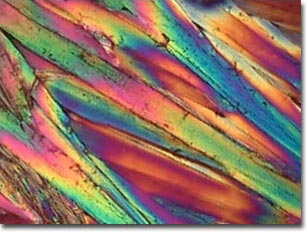Advanced Condenser Systems: Achromatic Condensers
TNT (trinitrotoluene) Crystallites
The images below compare performance of the Intel Play QX3 Computer Microscope with and without the aid of an organized cone of illumination from an achromatic substage condenser containing an aperture diaphragm. These photomicrographs are unretouched and were captured with the QX3 interactive software.
Birefringent TNT Crystallites


Trinitrotoluene is a nitrated toluene derivative that exists as a crystalline solid at room temperature and melts at 81 degrees centigrade. The chemical is prepared by carefully nitrating toluene, and is often used as a high explosive. Unlike nitroglycerin, trinitrotoluene does not explode when affected by ordinary shocks and jarring, and must be ignited with a detonation cap.
The images above were recorded using the Intel Play QX3 microscope in transmitted brightfield mode equipped with crossed polarizers and a full-wave retardation plate. On the top is a digital image from a stock QX3 microscope using auxiliary illumination provided by a fiber optic light pipe through a hole drilled into the mixing chamber. The image on the bottom was recorded using the QX3 microscope body and a Nikon achromatic substage condenser of low numerical aperture.
BACK TO TRANSMITTED POLARIZED ILLUMINATION GALLERY
